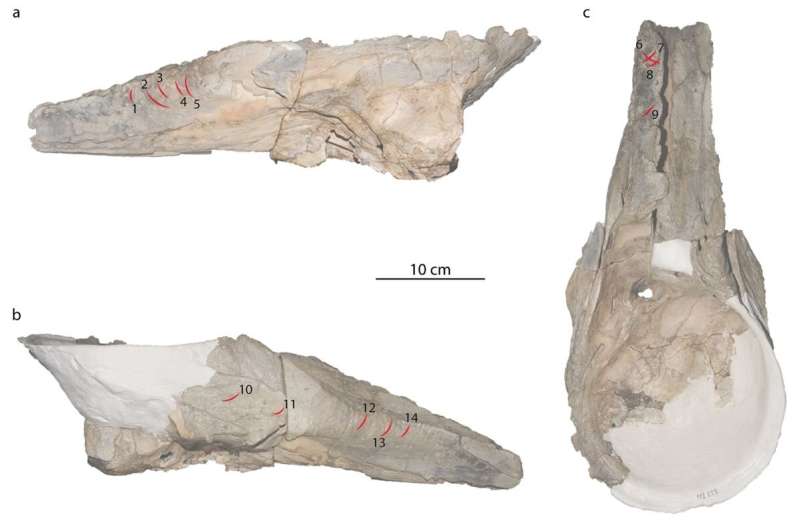June 30, 2022 report
Bite marks on ancient sperm whale relatives suggest sharks used them as fat sources

A small team of researchers from Switzerland, the U.S., Italy and Peru reports evidence that suggests ancestors of modern sperm whales were used as fat sources by ancient sharks. In their paper published in Proceedings of the Royal Society B, the group describes their study of physeteroid fossil bones dated to the late Miocene and found in Peru, and what it showed them about the feeding habits of ancient sharks.
The fossilized physeteroid skulls, from an ancient ancestor of modern sperm whales, were dated to approximately 7 million years ago. In their work, the researchers focused on the upper parts of the skulls housing the nasal passages. Modern sperm whales (and their ancient cousins) have large heads with a huge snout (often making up a third of its body length) and enlarged nasal organs. The whales use the organs for sound production, and they are chock full of fat. In this new effort, the researchers were interested in the bite marks found on all six of the skulls they studied. Study of the marks showed that they were created by sharks—and they were progressive. The researchers found that large sharks (possibly megalodons) attacked first. Next up came waves of smaller and smaller shark attacks.
Study of the bite marks showed that the whales tended to survive such attacks and that the sharks focused mainly on the part of the head housing the nasal organs. The researchers suggest this indicates that the sharks were going for the fat that surrounded them, giving the sharks a high-energy meal.
The researchers note that physeteroids were a widely diverse group during the Miocene, including whales of variable size. But all of them had the characteristic overly large head with the nasal organs that helped them communicate over long distances. They note that bite marks on cranial bones can only happen if the sharks were pulling out the tissue and fat covering them. They also note that similar bite marks have been observed on physeteroids from sites around the globe, suggesting that sharks actively sought them out, likely as a good source of fat.
More information: Aldo Benites-Palomino et al, Sperm whales (Physeteroidea) from the Pisco Formation, Peru, and their trophic role as fat sources for late Miocene sharks, Proceedings of the Royal Society B: Biological Sciences (2022). DOI: 10.1098/rspb.2022.0774
Journal information: Proceedings of the Royal Society B
© 2022 Science X Network





















